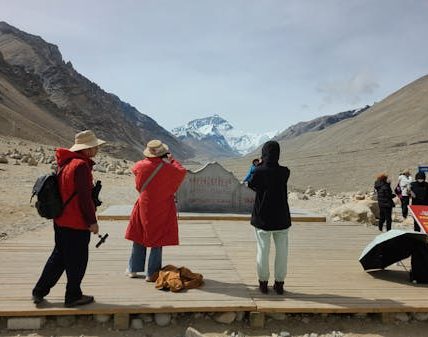Will the new James Bond embrace hi-tech gadgets in an age of AI? The films have a complicated history with technology
Development of a new James Bond film is underway at Amazon Studios, with the creater of Peaky Blinders, Steven Knight, now attached to write the screenplay, which will be directed by Denis Villeneuve.
The pair have given little away about what to expect from Bond 26. Knight said he wanted to do something “the same but different”, while Villeneuve said he would “honour the tradition” of the franchise. But a look back at how the films have dealt with key elements of Bond shows that following tradition can mean going in many different ways.
Take Bond’s toolbag of gadgets, which have been a part of the James Bond movies since their debut in the 1960s. Over the decades, the films have both leaned into and shifted away from the allure of hi-tech gadgetry in ways that plot key turning points in the franchise.
These peaks and troughs reflect what’s going on in the wider world as well as factors such as the influence of other successful film franchises. So with AI on the minds of many right now, the new film could embrace contemporary themes of technology. But re-booting the franchise when a new lead actor is cast is also often associated with a grittier or “back to basics” approach.
The first few Bond films starring Sean Connery, including Dr No (1962), From Russia With Love, and Goldfinger (1964) feature a smattering of spy technology. But by You Only Live Twice (1967), producers had opted for a space capsule hijack narrative – reflecting the influence of the US-Soviet space race – and a villain’s lair in a hollowed-out volcano.
However, the next entry – On Her Majesty’s Secret Service (1969) centred largely on the emotional realism of Bond’s (George Lazenby) courtship and subsequent marriage to Tracy di Vicenzo (Diana Rigg). The lesser focus on technology coincided with a new Bond actor – a pattern to be frequently repeated later on in the franchise. But for other reasons, the shift in tone was, perhaps, to be expected.
Goldfinger: Q introduces Bond to his Aston Martin.
Bond author Ian Fleming was writing On Her Majesty’s Secret Service at his holiday home – Goldeneye – in Jamaica, while Dr No was being filmed nearby. The book was published on April 1, 1963, the day From Russia With Love began filming (the film was released in October that year). The less gadget-focused approach of On Her Majesty’s Secret Service could be seen as a possible jab by Fleming at what he saw as the cinematic Bond’s growing overreliance on the latest tech.
Journeying back through the franchise, it is not hard to find instances where moments of technological excess are countered almost immediately by a more pared down, character-centred set of priorities.
After On Her Majesty’s Secret Service, Connery returned for one further Eon Productions film, Diamonds Are Forever (1971), which, like You Only Live Twice, featured a space-themed narrative. Live And Let Die (1973), Roger Moore’s debut as Bond, is somewhat more down to Earth and was the first film not to feature Bond’s gadgetmaster Q (who is referred to as Major Boothroyd in Dr No).
But a growing reliance on technology can be seen during the 70s Moore films, culminating with Moonraker (1979) – which was heavily influenced by Star Wars (1977) – in which Bond goes into space.
Moore’s follow-up, For Your Eyes Only (1981), was – as that film’s director John Glen noted – a film that went “back to the grass roots of Bond.” The global economic recession that took place between 1980 and 1982 certainly helped support this shift in tone.
For Your Eyes Only had a lower budget than Moonraker, so the filmmakers had to act in a similar way to their leading character, who made innovative use in the film of his shoelaces to climb up a rope on a sheer rock face in Greece.
The last few Roger Moore films have examples of Bond’s complex connection to technology, such as the computer microchip narrative of Moore’s final film A View to a Kill. But the next film, The Living Daylights (1987), was a return to the grittier Bond of the novels – with a focus on classic spycraft. From an action-packed opening in Gibraltar, the narrative moves to Bratislava where Dalton helps a KGB General defect to the west.
When Dalton departed after Licence to Kill (1989), which shows the influence of big-budget 80s Hollywood action movies, the series’ return after a six-year hiatus brought Bond into the information age. The cyberterrorist narrative of GoldenEye (1995), Pierce Brosnan’s debut as Bond, is fully indebted to a broader curiosity surrounding emerging internet sub-cultures.
The Living Daylights opening scene (official 007 YouTube)
Brosnan’s final outing, Die Another Day (2002) featured an Aston Martin that could turn invisible, which critics and audiences dismissed as a series nadir. The post-9/11 climate of protector narratives in defence of national security featured an altogether grittier action cinema counting Jason Bourne as its most popular hero. Die Another Day’s invisible Aston Martin and the indelible image of a computer-generated Bond surfing amid digital icebergs did not quite align with this state of post-millennial geopolitics.
Enter Daniel Craig, and the franchise’s emphatic declaration that it was going to do things for real, per the title of a documentary on Craig’s debut Casino Royale (2006). This was a statement of intent, anchored not just to a reduction in computer-generated imagery (CGI) behind-the-scenes, but equally by a turn away from the kinds of excessive technological wizardry that defined earlier instalments.
The absence of Q from Craig’s debut Casino Royale (2006) for the first time since Live and Let Die appeared to confirm a more “back to basics” feel. When the character did finally appear in Craig’s third film Skyfall (2012), Q (now played by Ben Whishaw) remarks to Bond: “Were you expecting an exploding pen? We don’t really go in for that anymore.”
Die Another Day trailer.
With another reboot on the way, the question now is whether the new film will draw inspiration from real-world technologies and push once more at the limits of technical innovation. Perhaps Villeneuve will exploit his science-fiction credentials finetuned in Arrival (2016), Blade Runner 2049 (2017) and his successful Dune films (2021-2024).
But given how contemporary cultural landscape is awash with the threat of AI, maybe the franchise does need to beat a hasty retreat from technology in order to stand out. Either way the filmakers will be able to argue they are sticking to tradition.
Christopher Holliday does not work for, consult, own shares in or receive funding from any company or organisation that would benefit from this article, and has disclosed no relevant affiliations beyond their academic appointment.


